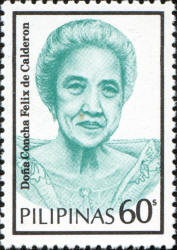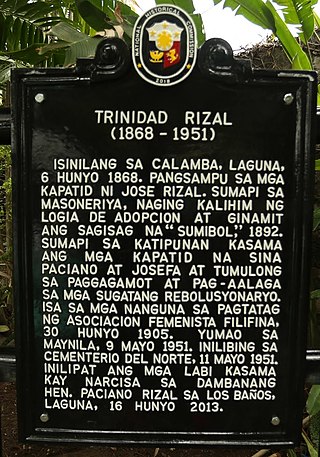A mail-order bride is a woman who lists herself in catalogs and is selected by a man for marriage. In the twentieth century, the trend primarily involved women living in developing countries seeking men from more developed nations. Men who list themselves in such publications are referred to as "mail-order husbands", although this is much less common. As of 2002, there were an estimated 100,000–150,000 mail order brides worldwide.

Filipino shamans, commonly known as babaylan, were shamans of the various ethnic groups of the pre-colonial Philippine islands. These shamans specialized in communicating, appeasing, or harnessing the spirits of the dead and the spirits of nature. They were almost always women or feminized men. They were believed to have spirit guides, by which they could contact and interact with the spirits and deities and the spirit world. Their primary role were as mediums during pag-anito séance rituals. There were also various subtypes of babaylan specializing in the arts of healing and herbalism, divination, and sorcery.

Lesbian, gay, bisexual and transgender people (LGBT) in the Philippines face legal challenges not faced by non-LGBT people, with numerous anti-discrimination legislations, bills and laws that are struggling to be passed on a national level to protect LGBT rights nationwide, with some parts of the country only existing on a local government level. LGBT individuals in the Philippines are often faced with disadvantages and difficulties in acquiring equal rights within the country. They also have a higher rate of suicide and suicide ideation compared to their heterosexual counterparts.

The lesbian, gay, bisexual, transgender and queer (LGBTQ) people in the Philippines have a distinctive culture in society, and also have limited legal rights. Gays and lesbians are more tolerated than accepted in Filipino society. Despite recent events that have promoted the rights, general acceptance, and empowerment of the Filipino LGBT community, discrimination remains. Homosexuals in the Philippines are known as "bakla", though there are other terms to describe them. According to the 2002 Young Adult Fertility and Sexuality Survey, 11 percent of sexually active Filipinos between the ages of 15 and 24 have had sex with someone of the same sex. According to Filipino poet and critic Lilia Quindoza Santiago, Filipino culture may have a more flexible concept of gender. Kasarian is defined in less binary terms than the English word; kasarian means "kind, species, or genus".
A plebiscite was held in the Philippines on April 30, 1937, to decide whether or not women could vote. Multiple women's movements started in 1910, which led to the plebiscite in 1937, where women voted for or against women's suffrage rights. Filipino women worked hard to mobilize and fight for women's suffrage in the early 1900s and gained victory after 447,725 out of 500,000 votes affirmed women's right to vote.

The Tagalog maginoo, the Kapampangan ginu, and the Visayan tumao were the nobility social class among various cultures of the pre-colonial Philippines. Among the Visayans, the tumao were further distinguished from the immediate royal families, the kadatuan.
Rape in the Philippines is considered a criminal offense. In Philippine jurisprudence, it is a heinous crime punishable by reclusión perpetua when committed against women. Rape of males is also legally recognized as rape by sexual assault, which is penalized by imprisonment of six to twelve years.
Filipino women writers have played important roles within Philippine literature, with Philippine women having created enduring works of fiction and non-fiction across the genres. Writing in English, Spanish, Filipino and other local languages and native dialects, female writers from the Philippine archipelago utilized literature, in contrast with the oral tradition of the past, as the living voices of their personal experiences, thoughts, consciousness, concepts of themselves, society, politics, Philippine and world history. They employed the "power of the pen" and the printed word in order to shatter the so-called "Great Grand Silence of the Centuries" of Filipino female members, participants, and contributors to the progress and development of the Philippine Republic, and consequently the rest of the world. Filipino women authors have "put pen to paper" to present, express, and describe their own image and culture to the world, as they see themselves.

The cultural achievements of pre-colonial Philippines include those covered by the prehistory and the early history (900–1521) of the Philippine archipelago's inhabitants, the pre-colonial forebears of today's Filipino people. Among the cultural achievements of the native people's belief systems, and culture in general, that are notable in many ethnic societies, range from agriculture, societal and environmental concepts, spiritual beliefs, up to advances in technology, science, and the arts.

In early Philippine history, barangay is the term historically used by scholars to describe the complex sociopolitical units that were the dominant organizational pattern among the various peoples of the Philippine archipelago in the period immediately before the arrival of European colonizers. Academics refer to these settlements using the technical term "polity", but they are usually simply called "barangays".

In the Philippines, a baklâ (Tagalog and Cebuano), bayot (Cebuano) or agî (Hiligaynon) is a person who was assigned male at birth and has adopted a gender expression that is feminine. They are often considered a third gender. Many bakla are exclusively attracted to men and some identify as women. The polar opposite of the term in Philippine culture is tomboy, which refers to women with a masculine gender expression. The term is commonly incorrectly applied to trans women.
Although Westernization and globalization have influenced Filipinos who live in the metropolitan areas, the overall culture remains quite conservative in its sexual values. Filipino sexuality is affected by education received by Filipinos from schools, the media, the rise of the internet, religious teachings from their churches or other similar spiritual institutions, legal policies and laws, and the influence of urbanization or urbanized regions in the Philippines. There are provisions and policies in the constitution of the Philippines which promulgates that the sexual act should happen only within the framework of married life between a man and woman, because this personal human expression is solidly connected to the family unit and to society as a whole.

Traditional marriage customs in the Philippines and Filipino wedding practices pertain to the characteristics of marriage and wedding traditions established and adhered by them Filipino men and women in the Philippines after a period of adoption courtship and engagement. These traditions extend to other countries around the world where Filipino communities exist. Kasalan is the Filipino word for "wedding", while its root word – kasal – means "marriage". The present-day character of marriages and weddings in the Philippines were primarily influenced by the permutation of Christian, both Catholic and Protestant, Hindu, Islam, Chinese, Spanish, and American models.
Violence against women in the Philippines includes different forms of gender-based violence. The term "violence against women" is "the word or concept (that) has been used in a broad, inclusive manner to encompass verbal abuse, intimidation, physical harassment, homicide, sexual assault, and rape." This form of violence is gender-biased. Violence occurs precisely because of their gender, specifically because the victims are women.
The evolution and history of women in Asia coincide with the evolution and history of Asian continent itself. They also correspond with the cultures that developed within the region. Asian women can be categorically grouped as women from the Asian subregions of Central Asia, East Asia, North Asia, South Asia, Southeast Asia, and Western Asia.

Concepción Felix Roque was a Filipina feminist and human rights activist. She established one of the first women's organizations in the Philippines, Asociación Feminista Filipina, as well as one of the first humanitarian NGOs, La Gota de Leche, aimed specifically at the well-being of mothers and their children. On several occasions, she spoke to legislators to promote women's enfranchisement. She has been recognized as one of the first feminists of the Philippines and was honored with many awards.
The position of the Philippines on women's rights is relatively developed compared to many other nations. Over the past century, noticeable developments have been made which have led to greater endorsement and protection of these rights. The progression towards gender equality came about through women's movements, increased numbers of women political representatives, increased numbers of educated women, greater specificity on women's issues instituted under legislation, and the focused application of those laws. In recent years, the Filipino government has addressed the rights of women under a multitude of legislative schemes including workplace discrimination, domestic violence, sexual harassment and human trafficking.

Trinidad Fernandez Legarda was a Filipina suffragist, clubwoman, philanthropist, and editor. She was the first woman ambassador from the Philippines, when she was appointed in 1958.

Mga kababayang dalaga ng Malolos, also known by its alternative English title To the young women of Malolos, is a letter written by Filipino author and political reformer José Rizal on February 22, 1889. It is written in Tagalog and is addressed to a group of women from Malolos, Bulacan who successfully lobbied the Spanish colonial government to allow them to open a school so that they could study the Spanish language.

Trinidad Rizal y Alonso, commonly known as Trinidad Rizal, was a Filipina feminist leader and co-founder of the Philippines' first feminist organization, the Asociación Femenista Filipina. She was the tenth sibling of the national hero, physician and writer, Dr. José Rizal.
















